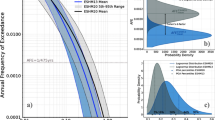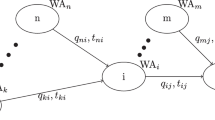Abstract
Given a changing environment, estimating a flood magnitude corresponding to a desired return period considering nonstationarity is crucial for hydrological engineering designs. Four nonstationary design methods, namely expected waiting time (EWT), expected number of exceedances (ENE), equivalent reliability (ER), and average design life level (ADLL) have already been proposed in recent years. Among them, the EWT method needs to estimate design flood magnitudes by solving numerically. In addition, EWT requires estimating design quantiles for infinite lifespan, or extrapolation time (textra), to guarantee the convergence of the EWT solution under certain conditions. However, few studies have systematically evaluated pros and cons of the EWT method as to how to determine the textra and what kinds of misunderstandings on the applicability of the EWT method exist. In this study, we aim to provide the first investigation of various factors that influence the value of textra in the EWT method, and provide comprehensive comparison of the four methods from the perspectives of textra, design values and associated uncertainties. The annual maximum flood series (AMFS) of 25 hydrological stations, with increasing and decreasing trends, in Pearl River and Weihe River were chosen for illustrations. The results indicate that: (1) the textra of EWT is considerably affected by the trend of AMFS and the choice of extreme distributions. In other words, the textra of stations with increasing trends was significantly smaller than that of stations with decreasing trends, and the textra was also larger for distributions with heavier tail; (2) EWT produced larger design values than ENE for increasing trends, and both EWT and ENE yielded larger design values than ER and ADLL for higher return periods, while complete opposite results were obtained for decreasing trends.







Similar content being viewed by others
Change history
01 July 2020
The original version of this article unfortunately contains mistakes in equations 1 and 2.
References
Acero JF, Parey S, García AJ, Dacunha-Castelle D (2018) Return level estimation of extreme rainfall over the Iberian Peninsula: comparison of methods. Water 10(2):179
Akaike H (1974) A new look at the statistical model identification. IEEE T Automat Contr 19(6):716–723
Cooley D (2013) Return periods and return levels under climate change. In: AghaKouchak A, Easterling D, Hsu K, Schubert S, Sorooshian S (eds) Extremes in a changing climate. Springer, Dordrecht, Netherlands, pp 97–114
El Adlouni S, Bobée B, Ouarda T (2008) On the tails of extreme event distributions in hydrology. J Hydrol 355(1–4):16–33
Gu X, Zhang Q, Singh VP, Xiao M, Cheng J (2017) Nonstationarity-based evaluation of flood risk in the Pearl River basin: changing patterns, causes and implications. Hydrol Sci J 62(2):246–258
Hu Y, Liang Z, Chen X, Liu Y, Wang H, Yang J, Wang J, Li B (2017) Estimation of design flood using EWT and ENE metrics and uncertainty analysis under non-stationary conditions. Stoch Env Res Risk A 31(10):2617–2626
Hu Y, Liang Z, Singh VP, Zhang X, Wang J, Li B, Wang H (2018) Concept of equivalent reliability for estimating the design flood under non-stationary conditions. Water Resour Manag 32(3):997–1011
Jiang C, Xiong L, Yan L, Dong J, Xu C-Y (2019) Multivariate hydrologic design methods under nonstationary conditions and application to engineering practice. Hydrol Earth Syst Sci 23(3):1683–1704
Kang L, Jiang S, Hu X, Li C (2019) Evaluation of return period and risk in bivariate non-stationary flood frequency analysis. Water 11(1):79
Khaliq MN, Ouarda TBMJ, Ondo JC, Gachon P, Bobée B (2006) Frequency analysis of a sequence of dependent and/or non-stationary physically-based observations: a review. J Hydrol 329(3–4):534–552
Li J, Lei Y, Tan S, Bell CD, Engel BA, Wang Y (2018) Nonstationary flood frequency analysis for annual flood peak and volume series in both univariate and bivariate domain. Water Resour Manag 32(13):4239–4252
Lu M, Xu Y, Shan N, Wang Q, Yuan J, Wang J (2019) Effect of urbanisation on extreme precipitation based on nonstationary models in the Yangtze River Delta metropolitan region. Sci Total Environ 673:64–73
Obeysekera J, Salas J (2016) Frequency of recurrent extremes under nonstationarity. J Hydrol Eng 21(5):04016005
Olsen R, Lambert JH, Haimes YY (1998) Risk of extreme events under nonstationary conditions. Risk Anal 18:497–510
Parey S, Malek F, Laurent C, Dacunha-Castelle D (2007) Trends and climate evolution: statistical approach for very high temperatures in France. Clim Chang 81(3–4):331–352
Parey S, Hoang TTH, Dacunha Castelle D (2010) Different ways to compute temperature return levels in the climate change context. Environmetrics 21(7–8):698–718
Prosdocimi I, Kjeldsen TR, Miller JD (2015) Detection and attribution of urbanization effect on flood extremes using nonstationary flood-frequency models. Water Resour Res 51(6):4244–4262
Read LK, Vogel RM (2015) Reliability, return periods, and risk under nonstationarity. Water Resour Res 51(8):6381–6398
Rigby RA, Stasinopoulos DM (2005) Generalized additive models for location, scale and shape. J Roy Stat Soc C Appl Stat 54(3):507–554
Rootzén H, Katz RW (2013) Design life level: quantifying risk in a changing climate. Water Resour Res 49(9):5964–5972
Salas JD, Obeysekera J (2014) Revisiting the concepts of return period and risk for nonstationary hydrologic extreme events. J Hydrol Eng 19(3):554–568
Serago JM, Vogel RM (2018) Parsimonious nonstationary flood frequency analysis. Adv Water Resour 112:1–16
Su C, Chen X (2019) Assessing the effects of reservoirs on extreme flows using nonstationary flood frequency models with the modified reservoir index as a covariate. Adv Water Resour 124:29–40
Wang H, Mei C, Liu J, Shao W (2018) A new strategy for integrated urban water management in China: sponge city. Sci China Technol Sci 61(3):317–329
Wang J, Xu Y, Wang Y, Yuan J, Wang Q, Xiang J (2019) Non-stationarity analysis of extreme water level in response to climate change and urbanization in the Taihu Basin, China. Stoch Env Res Risk A 33(3):891–904
Xie P, Wu Z, Sang Y, Gu H, Zhao Y, Singh VP (2018) Evaluation of the significance of abrupt changes in precipitation and runoff process in China. J Hydrol 560:451–460
Xiong L, Yan L, Du T, Yan P, Li L, Xu W (2019) Impacts of climate change on urban extreme rainfall and drainage infrastructure performance: a case study in Wuhan City, China. Irrig Drain 68(2):152–164
Xu W, Jiang C, Yan L, Li L, Liu S (2018) An adaptive Metropolis-Hastings optimization algorithm of Bayesian estimation in non-stationary flood frequency analysis. Water Resour Manag 32(4):1343–1366
Yan L, Xiong L, Guo S, Xu C-Y, Xia J, Du T (2017a) Comparison of four nonstationary hydrologic design methods for changing environment. J Hydrol 551:132–150
Yan L, Xiong L, Liu D, Hu T, Xu C-Y (2017b) Frequency analysis of nonstationary annual maximum flood series using the time-varying two-component mixture distributions. Hydrol Process 31(1):69–89
Yan L, Xiong L, Ruan G, Xu C-Y, Yan P, Liu P (2019) Reducing uncertainty of design floods of two-component mixture distributions by utilizing flood timescale to classify flood types in seasonally snow covered region. J Hydrol 574:588–608
Zeng H, Feng P, Li X (2014) Reservoir flood routing considering the nonstationarity of flood series in North China. Water Resour Manag 28(12):4273–4287
Zhang Q, Gu X, Singh VP, Shi P, Sun P (2018a) More frequent flooding? Changes in flood frequency in the Pearl River basin, China, since 1951 and over the past 1000 years. Hydrol Earth Syst Sci 22(5):2637–2653
Zhang W, Villarini G, Vecchi GA, Smith JA (2018b) Urbanization exacerbated the rainfall and flooding caused by hurricane Harvey in Houston. Nature 563(7731):384–388
Acknowledgements
This study is financially supported jointly by the National Natural Science Foundation of China (No. 51879066, 51525902, 51909053, 51809243), the Research Council of Norway (FRINATEK Project 274310), the Ministry of Education “111 Project” Fund of China (B18037), the Natural Science Foundation of Hebei Province (E2019402076), the Youth Foundation of Education Department of Hebei Province (QN2019132) and the Science Foundation for Post Doctorate Research of Shaanxi Province (2018BSHQYXMZZ06), all of which are greatly appreciated. Great thanks are due to the editor and reviewers, as their comments are all valuable and very helpful for improving the quality of this paper.
Author information
Authors and Affiliations
Corresponding author
Additional information
Publisher’s Note
Springer Nature remains neutral with regard to jurisdictional claims in published maps and institutional affiliations.
Rights and permissions
About this article
Cite this article
Yan, L., Xiong, L., Luan, Q. et al. On the Applicability of the Expected Waiting Time Method in Nonstationary Flood Design. Water Resour Manage 34, 2585–2601 (2020). https://doi.org/10.1007/s11269-020-02581-w
Received:
Accepted:
Published:
Issue Date:
DOI: https://doi.org/10.1007/s11269-020-02581-w




